Pale yellow owl
| Pale yellow owl | ||||||||||||
|---|---|---|---|---|---|---|---|---|---|---|---|---|

Pale yellow owl ( Xanthia icteritia ) |
||||||||||||
| Systematics | ||||||||||||
|
||||||||||||
| Scientific name | ||||||||||||
| Xanthia icteritia | ||||||||||||
| ( Hufnagel , 1766) |
The pale yellow owl ( Xanthia icteritia ) or pale willow yellow owl is a butterfly from the owl butterfly family (Noctuidae). The moths are distinct autumn butterflies and fly in hedges and shrubbery in August and October.
features
In contrast to the very similar willow yellow owl ( Xanthia togata ), the pale yellow owl differs in its variable, red-violet markings on the wings, which are usually not in the form of a coherent band. In some cases it is completely absent, instead the wings show only a small annular spot.
The red-brown caterpillar , drawn with dark dots and light lines, first lives on pussy willows in spring. In later stages of development, the caterpillars get onto the ground vegetation with the male catkins that fall off when they wither, and eat there "polyphagous" from various lower herbs. The caterpillars, which feed themselves polyphagously in their later stages, are found not only on sal willows ( Salix caprea ) but also on aspen ( Populus tremula ); later also on cowflower ( Taraxacum ), plantain ( Plantago ), blackberries ( Rubus fruticosus ) and bogberry ( Vaccinium uliginosum ). The pupation takes place in a cocoon in the soil in which the caterpillar spends some time as a resting larva.
The eggs overwinter.
Similar species
- Violet-Yellow Owl ( Xanthia togata ) ( Esper , [1778])
- Linden yellow owl ( Tiliacea citrago ) ( Linnaeus , 1758)
- European beech yellow owl ( Tiliacea aurago ) ( Denis & Schiffermüller , 1775)
Occurrence
The animals are still quite common in most areas of Central Europe. They prefer forest edges with willow bushes, wet meadows or the banks of bodies of water, as their main forage plant, the Sal willow , also grows there.
swell
literature
- Michael Chinery: Parey's Book of Insects , Franckh-Kosmos, Stuttgart 2000, ISBN 978-3-440-09969-8 .
- Heiko Bellmann : The new Kosmos butterfly guide. Butterflies, caterpillars and forage plants. 2nd Edition. Franckh-Kosmos, Stuttgart 2009, ISBN 978-3-440-11965-5 .
Web links
- Floraweb: http://www.floraweb.de
- Lepiforum: http://www.lepiforum.de